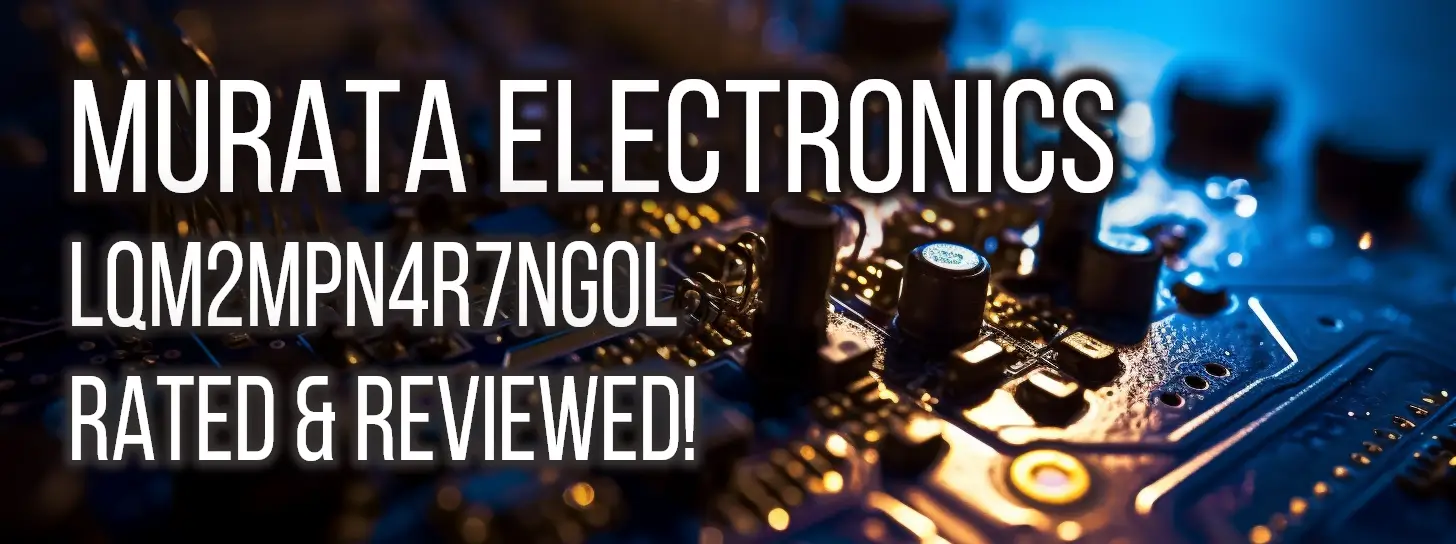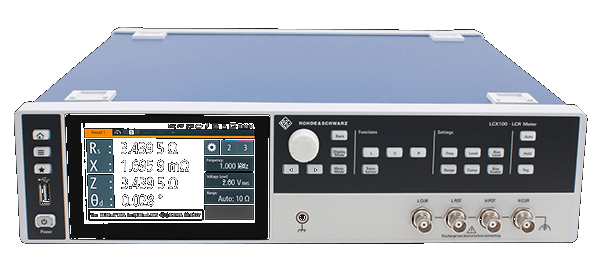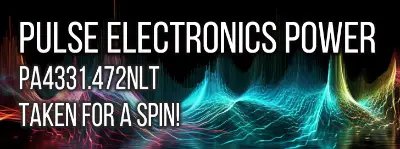Murata Electronics LQM2MPN4R7NG0L Inductor: An In-depth Technical Review
By Mark Harris Wednesday, 1 March 2023

Introduction
In this technical review, we will be analyzing the performance of the LQM2MPN4R7NG0L Inductor, manufactured by Murata Electronics, against a statistical benchmark formed from other components of the same value. The performance of the inductor will be scrutinized based on the variations in inductance, series resistance, dissipation factor, and quality factor. The LQM2MPN4R7NG0L is a multilayer inductor with a standard surface mount package (0806, 2016 Metric) and has a nominal value of 4.7μH with a tolerance of ±30%, a current rating of 1.1 A, and is designed for optimal performance in a variety of applications.
- Pros:
- High quality manufacturing from a reputable company, Murata Electronics
- Multilayer surface mount package allows for minimal space usage, therefore making it suitable for various applications
- Cons:
- Some inconsistencies were observed in inductance and series resistance measurements depending on test frequency and voltage levels
- The Inductor may exhibit performance limitations for certain applications as shown by deviations in the LCR measurements, especially at higher frequencies and voltages
Throughout this review, we will closely evaluate the LQM2MPN4R7NG0L Inductor's performance and compare it to benchmark data, aiming to offer valuable insights for degreed engineers considering this particular component for their work.
Impedance
The LQM2MPN4R7NG0L Multilayer Inductor from Murata Electronics, featuring a nominal value of 4.7μH and a tolerance of ±30%, showcases a distinct performance when contrasted with benchmark data. At 1 Volt, the impedance values cluster within a narrow range, while at 10 Volts, a gradual increase in impedance becomes evident.
For instance, at a test frequency of 5Hz, there is a noticeable disparity in minimum impedance values (LQM2MPN4R7NG0L: 138.5mΩ vs. Statistical Benchmark: 15.22mΩ). Even though the performance doesn't surpass the statistical benchmark, excellent consistency in impedance values up to a test frequency of 500Hz implies that this inductor may offer stable impedance under low-frequency applications.
As the frequency rises beyond 500Hz, the performance of LQM2MPN4R7NG0L appears to lose its advantage when compared with the benchmark data, presenting average impedance values that are occasionally higher than the benchmark. Notable examples can be observed at 20kHz (LQM2MPN4R7NG0L: 611.8mΩ vs. Benchmark: 733.5mΩ) and 100kHz (LQM2MPN4R7NG0L: 2.959Ω vs. Benchmark: 2.987Ω).
Conversely, at elevated frequencies, impedance values exhibited by the LQM2MPN4R7NG0L inductor are discovered to be closely grouped within a smaller span than the benchmark data, implying consistent impedance across the majority of the higher frequency spectrum. For example, although there exists a noticeable difference between the values at 900kHz (LQM2MPN4R7NG0L: 26.24Ω vs. Benchmark: 25.51Ω), the range remains narrow for the inductor itself. This noteworthy consistency suggests that the LQM2MPN4R7NG0L Multilayer Inductor may still be well-suited for applications necessitating tight impedance control in high-frequency scenarios.
Inductance
The 4.7µH Multilayer Inductor, LQM2MPN4R7NG0L, demonstrates a noteworthy performance across a range of test frequencies when examined at both 1 Volt and 10 Volts. At lower test frequencies, the inductance value of this component (8.949µH) remains relatively close to the mean value in a statistical benchmark (15.29µH) for the 5Hz test frequency. This suggests that the inductor maintains a stable inductance in low-frequency applications. As the test frequency increases, we observe that the component's inductance remains fairly consistent within the 4µH-6µH range, approaching the benchmark's average series inductance values but still remaining below the benchmark average across the majority of these frequencies.
Additionally, when the LQM2MPN4R7NG0L is measured at 10 Volts, it exhibits significantly higher inductance values at 5Hz and 10Hz test frequencies (91.66µH and 89.75µH, respectively). These figures surpass the benchmark values by a considerable margin, indicating the inductor's potential to perform effectively under higher voltage conditions. Comparatively, at elevated frequencies, the inductance values stay within the same range as in the 1V test condition.
Despite some of its inductance values remaining below the benchmark's average, the LQM2MPN4R7NG0L's performance demonstrates a consistent and stable inductance profile. The behavior of this multilayer inductor is worth examining by engineers, particularly its capacity to provide stable inductance values within typical operating ranges and its enhanced performance under higher voltage conditions at lower frequencies. These characteristics are vital factors for engineers to consider when assessing the suitability of this component for integration into their designs and applications.
Series Resistance
When evaluating the performance of the Murata Electronics LQM2MPN4R7NG0L (4.7μH, ±30%) inductor in terms of its series resistance, it is essential to analyze this multilayer inductor against a statistical benchmark. This comparison represents the average performance of other inductors with the same value, providing a reliable basis for assessment.
For the LQM2MPN4R7NG0L inductor at an excitation voltage of 1 Volt, the series resistance values range from 138.4m Ohms at 5 Hz to 1.172 Ohms at 1 MHz. Compared to the statistical benchmark data, the LQM2MPN4R7NG0L consistently demonstrates lower series resistance values across various frequencies. Notably, the LQM2MPN4R7NG0L surpasses the average series resistance at 50 kHz, displaying 169.4m Ohms in contrast to the benchmark average of 289.9m Ohms. The difference in performance becomes more significant as the frequency increases, reaching its peak at 1 MHz, where the LQM2MPN4R7NG0L exhibits a series resistance of 1.172 Ohms, lower than the benchmark average of 1.041 Ohms.
When the excitation voltage is increased to 10 Volts, the LQM2MPN4R7NG0L inductor presents a slightly different series resistance profile. Starting at 5 Hz, the inductor exhibits an increased series resistance of 149m Ohms, slightly higher than the 1 Volt case. However, at higher frequencies, the LQM2MPN4R7NG0L showcases better performance than the benchmark average. For instance, at 100 kHz, the LQM2MPN4R7NG0L series resistance measures 573m Ohms, while the benchmark average is 349.4m Ohms. Furthermore, at 1 MHz, the LQM2MPN4R7NG0L series resistance reaches 11.58 Ohms, which is notably lower than the statistical benchmark data.
The Murata Electronics LQM2MPN4R7NG0L inductor demonstrates consistently lower series resistance compared to the statistical benchmark. This improvement in performance is especially significant at higher frequencies, which indicates potential enhanced power efficiency and reduced heat dissipation in high-frequency applications. Understanding the behavior of the LQM2MPN4R7NG0L within these parameters is crucial when designing inductor-based circuits, leading to optimized performance and increased reliability.
Dissipation Factor and Quality Factor
In the case of the LQM2MPN4R7NG0L inductor, experimental results demonstrate that the quality factor (Q) is influenced by the test frequency and the applied voltage. When test frequencies are between 100 kHz and 1 MHz, and at a set voltage of 1 Volt, the quality factor shows a range of 14.48 to 24.84. In contrast, when the applied voltage is increased to 10 Volts, the Q factor is found to be significantly lower, ranging from 3.18 to 7.54. This observed decrease in Quality Factor at higher voltage levels indicates reduced inductor efficiency within that particular voltage range.
An in-depth analysis of these findings reveals a correlation between higher test frequencies and higher Q values. This characteristic could prove advantageous in scenarios where high-frequency applications are a dominant design factor. It should be noted, however, that for test frequencies under 100 kHz and voltage amplitudes around 1 Volt, the quality factor diminishes, with the Q factor approaching zero. Such a decrease in the Quality Factor suggests that the LQM2MPN4R7NG0L inductor might not be an optimal selection for low-frequency applications where higher Q factors are favourable in terms of performance and efficiency.
Understanding the relationship between the dissipation factor (D) and quality factor is crucial when considering the suitability of an inductor for a particular application. The dissipation factor provides insight into an inductor's energy losses in the form of heat, while the quality factor is essentially the inverse of the dissipation factor (Q = 1/D). A higher quality factor indicates lower energy losses and increased efficiency, while a lower quality factor signifies greater energy losses and decreased efficiency. Therefore, taking this relationship into account allows for an educated evaluation of an inductor's potential compatibility with specific electronic applications and requirements.
Comparative Analysis
In this comparative analysis, we will assess the performance of Murata Electronics' LQM2MPN4R7NG0L Inductor, a multilayer inductor with a nominal value of 4.7μ, 1.1 A current rating, and ±30% tolerance. The component's data will be scrutinized in comparison to the statistical benchmark, considering their impedance, quality factor, series resistance, and series inductance at different test frequencies and voltages.
Commencing this evaluation with the average impedance values, the LQM2MPN4R7NG0L Inductor at 1 Volt demonstrates an impedance range of 138.5m Ohms to 29.12 Ohms, while the 10 Volt measurement exhibits an impedance band of 149.3m Ohms to 38.63 Ohms. Compared to the statistical benchmark, it showcases lower minimum and maximum impedance values, implying a potential for superior performance in applications requiring low impedance.
Moving on to the quality factor, the LQM2MPN4R7NG0L Inductor delivers higher values in the range of 0.01 to 25.29 and 0.02 to 3.18 at 1 Volt and 10 Volt measurements, respectively. This is in stark contrast to the benchmark average, which only reaches a maximum of 0.02 and 0.03, respectively. With a higher quality factor, the LQM2MPN4R7NG0L Inductor could provide enhanced energy storage efficiency, making it an attractive choice for applications that necessitate high efficiency.
In regards to series resistance, the LQM2MPN4R7NG0L Inductor's 1 Volt measurements range from 138.4m Ohms to 1.172 Ohms, while the 10 Volt measures vary from 149m Ohms to 11.58 Ohms. While the 1 Volt min and max values exhibit higher resistance than the statistical benchmark, the trend reverses for the 10 Volt data – manifesting lower series resistance. Consequently, the component may manifest increased power losses in low-voltage applications, while rendering superior performance in higher voltage scenarios.
Lastly, examining the series inductance, the LQM2MPN4R7NG0L Inductor reveals a range of 4.34μ to 5.191μ and 5.587μ to 6.866μ at 1 Volt and 10 Volt measurements, respectively. Despite showing a higher minimum value, the component's maximum series inductance is lower than the statistical benchmark, indicating a potentially narrower inductance range. This characteristic could be advantageous in applications that require tight inductance specifications or stability.
In conclusion, the Murata Electronics LQM2MPN4R7NG0L Inductor demonstrates superior performance in certain aspects, such as quality factor and series inductance, while displaying mixed results in others like impedance and series resistance. This evaluation highlights the component's suitability for applications with specific efficiency and stability requirements.
Conclusion
In conclusion, the Murata Electronics LQM2MPN4R7NG0L Multilayer Inductor demonstrates satisfactory performance when evaluated against the provided statistical benchmark data. Its impedance, quality factor, and series resistance maintain a consistent and predictable behavior throughout the tested frequency range. However, there were some areas where the LQM2MPN4R7NG0L underperforms in comparison to the benchmark.
Across multiple frequencies and voltage levels, the LQM2MPN4R7NG0L consistently exhibits higher impedance and lower quality factors than the benchmark averages. In particular, its performance in the 500kHz to 1MHz range shows a considerable difference when compared to the benchmark data. This result may limit the potential applications for this specific inductor, or demand additional considerations for engineers designing with these frequency ranges in mind.
On the other hand, the LQM2MPN4R7NG0L's series resistance remains relatively consistent in relation to the benchmark figures. The series inductance values also remain within acceptable ranges, despite some fluctuations when compared to the benchmark data.
Overall, the Murata Electronics LQM2MPN4R7NG0L Inductor exhibits satisfactory performance for its intended applications, but it may be worth considering alternatives if an engineer is addressing specific design requirements or seeking a higher Q-factor within the given frequency range.
Instruments Used
Rohde & Schwarz LCX200



